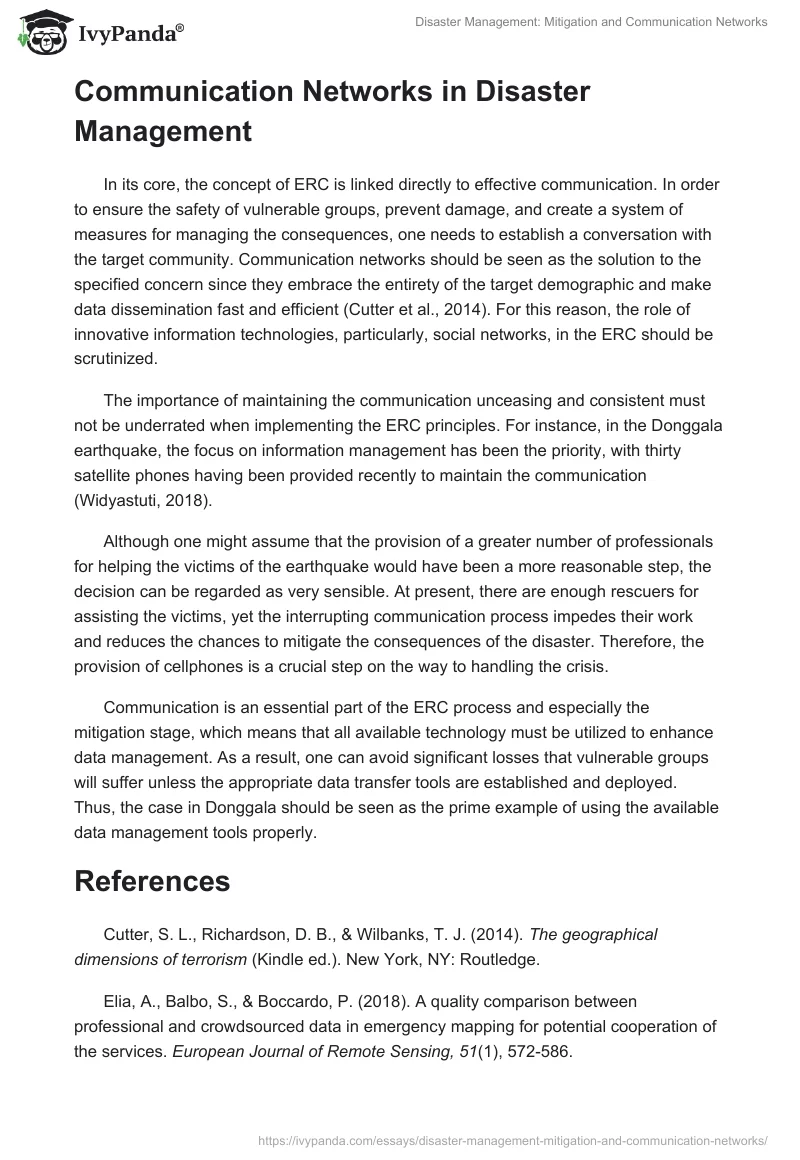Mitigation: Definition and Strategies
Building the levels of disaster preparedness is critical to the prevention of damage and destruction that cataclysms typically entail. Mitigation is an important stage of disaster management and, particularly, the emergency response cycle (ERC) (Cutter, Richardson, & Wilbanks, 2014). According to the current definition, mitigation is the set of strategies designed to minimize the negative outcomes of a disaster (Elia, Balbo, & Boccardo, 2018).
The notion is often conflated with the concept of preparedness due to the focus on the outcomes of a disaster. However, there is a difference between the two concepts. While preparedness, in its essence, implies building awareness before the disaster occurs to avoid the drastic outcomes, mitigation suggests handling the consequences of a cataclysm (Cutter et al., 2014). Therefore, mitigation should not be overlooked and needs to be recognized as one of the crucial elements of the ERC.
Since disasters vary in nature and outcomes, different mitigation strategies exist. The approaches to mitigation share the same structure and goals, being primarily aimed at arranging the available resources either to reinforce security or to ensure the availability of food, water, and other essential items for survivors. However, their focus varies depending on the type of a disaster that they are supposed to help to address.
Examples of mitigation strategies include the mapping of existing hazards, creation of reinforced rooms where people can be safe from tornadoes, and elevation of houses built in the areas prone to floods (Cutter et al., 2014). While the specified strategies can be seen as a part of the avoidance practice, they imply taking measures to handle the physical consequences of disasters. As a result, a significant amount of damage can be contained in a very small area.
Communication Networks in Disaster Management
In its core, the concept of ERC is linked directly to effective communication. In order to ensure the safety of vulnerable groups, prevent damage, and create a system of measures for managing the consequences, one needs to establish a conversation with the target community. Communication networks should be seen as the solution to the specified concern since they embrace the entirety of the target demographic and make data dissemination fast and efficient (Cutter et al., 2014). For this reason, the role of innovative information technologies, particularly, social networks, in the ERC should be scrutinized.
The importance of maintaining the communication unceasing and consistent must not be underrated when implementing the ERC principles. For instance, in the Donggala earthquake, the focus on information management has been the priority, with thirty satellite phones having been provided recently to maintain the communication (Widyastuti, 2018).
Although one might assume that the provision of a greater number of professionals for helping the victims of the earthquake would have been a more reasonable step, the decision can be regarded as very sensible. At present, there are enough rescuers for assisting the victims, yet the interrupting communication process impedes their work and reduces the chances to mitigate the consequences of the disaster. Therefore, the provision of cellphones is a crucial step on the way to handling the crisis.
Communication is an essential part of the ERC process and especially the mitigation stage, which means that all available technology must be utilized to enhance data management. As a result, one can avoid significant losses that vulnerable groups will suffer unless the appropriate data transfer tools are established and deployed. Thus, the case in Donggala should be seen as the prime example of using the available data management tools properly.
References
Cutter, S. L., Richardson, D. B., & Wilbanks, T. J. (2014). The geographical dimensions of terrorism (Kindle ed.). New York, NY: Routledge.
Elia, A., Balbo, S., & Boccardo, P. (2018). A quality comparison between professional and crowdsourced data in emergency mapping for potential cooperation of the services. European Journal of Remote Sensing, 51(1), 572-586.
Widyastuti, A. Y. (2018). Donggala Quake; Minister Rudiantara sends 30 satellite phones. Tempo.Co. Web.


